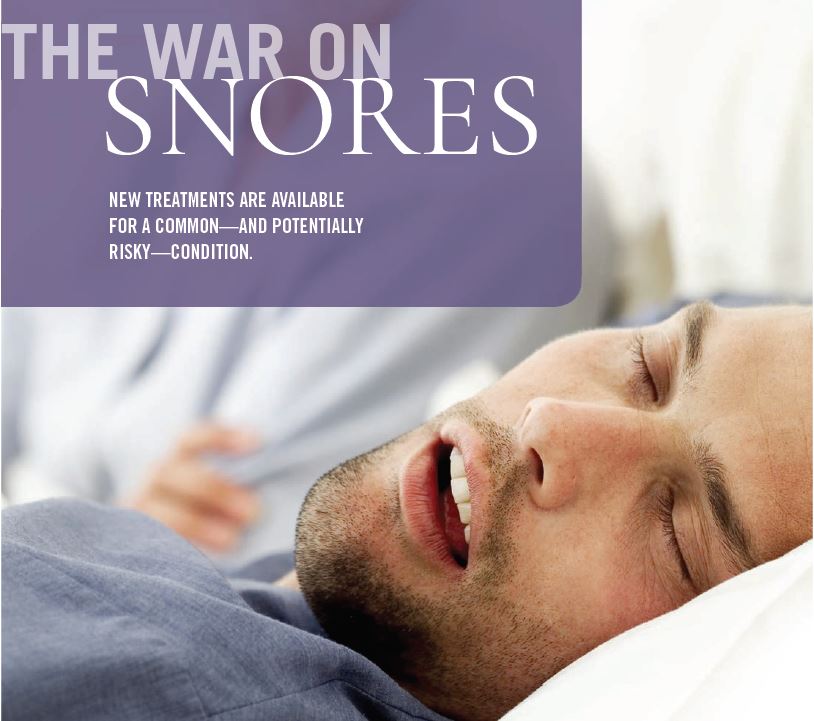Snoring is common and often viewed as benign. However, snoring is one of the symptoms of obstructive sleep apnea, and could potentially lead to serious health problems. “Sleep apnea is a ‘life-depreciating’ condition,” says neurologist Mangala Nadkarni, MD, Director of the Center for Sleep Disorders at Saint Barnabas Medical Center (SBMC). It’s important to take snoring seriously—and take action if needed.
Snoring vs. Sleep Apnea
Snoring occurs when soft throat and tongue tissues relax, narrowing the airway and making tissues vibrate with breathing. “When wind goes through a narrow tunnel, it makes more noise,” explains Dr. Nadkarni. “The same is true in your airway.”
With obstructive sleep apnea, soft tissues collapse into the airway and completely block the flow of oxygen to the whole body, including vital organs such as the heart and brain. In an attempt to restore the oxygen level, the nervous system then disrupts sleep momentarily to make the sleeper draw air, often with a snort or gasp. The sleep-choke-gasp pattern repeats throughout the night, compromising deep, restful slumber.
“Snoring is not always a serious concern,” Dr. Nadkarni says. “But if it’s accompanied by other symptoms, we recommend having a sleep study done.”
Symptoms of Sleep Apnea
Beyond snoring, major signs of sleep apnea include:
- Interrupted sleep.
- Waking up tired and feeling tired during the day, even though you’ve had seven or more hours of sleep at night.
- Frequently getting up to use the bathroom at night. This may be due to kidneys producing more urine when the body is oxygen-deprived.
- Waking up with dull headaches that may or may not require medication.
- High blood sugar upon awakening, which may be caused by stress hormones released during sleep apnea episodes.
“If sleep apnea is undiagnosed and left untreated, it can lead to serious health conditions including difficult-to-control blood pressure; difficult-to-control diabetes; irregular heart rate, such as atrial fibrillation; heart failure, stroke, and as per recent research, memory decline,” Dr. Nadkarni says.
“In addition, drowsy driving has become a public health issue because it can lead to massive damage to property and loss of life,” she says. “Commercial drivers, such as truck and train drivers, are now regularly tested for sleep apnea.”
Making the Diagnosis
The Center for Sleep Disorders at SBMC can provide tools to help snorers diagnose obstructive sleep apnea. “In most cases, we get all the information we need from a sleep study that you can do at home,” Dr. Nadkarni says. Tests entail wearing one of two types of devices to bed at night.
One device is worn on the wrist and connects by wires to monitors in the heart area and neck that measure breathing and heartbeat. Alternatively, a different device can be worn in a headband with wire connections to the heart area and a nasal cannula, or air tube, going to the nose.
“If unusual behavior, such as sleepwalking or acting out of dreams, occurs during the night, we prefer that you come to the center’s lab for an overnight sleep study,” Dr. Nadkarni says. A neurological problem such as restless legs or a lung condition such as chronic obstructive pulmonary disease (COPD) that may be related to (or worsen) sleep apnea can also be better evaluated with the center’s in-house, state-of-the-art technologies.
Treatment Options
Mild cases of snoring or sleep apnea can sometimes be resolved with relatively simple measures:
A positional pillow: “Many people experience sleep apnea when they lie on their backs but not their sides,” Dr. Nadkarni says. A special pillow can prevent you from rolling onto your back from a side-sleeping position.
Provent therapy: Disposable valve-like devices worn over the nostrils can help you inhale normally but exhale slowly. This creates pressure that keeps airways open without use of a mask or powered device.
A dental device: A mouthguard-like dental device pulls the lower jaw forward during sleep so the airway stays open, preventing both snoring and sleep apnea.
Weight loss often substantially reduces snoring and sleep apnea as well.
When none of these remedies is an option for correction of sleep apnea, other treatments include:
Continuous positive airway pressure (CPAP): CPAP entails using a machine that provides constant air pressure, generally through a mask that covers your face or nose, to keep your airway open during sleep.
One variation on CPAP is an auto-adjusting PAP device that detects a person’s breathing pattern and modulates the amount of pressure as he or she inhales and exhales. Another variation, called bilevel positive airway pressure (BiPAP), provides a set amount of higher pressure for inhalation and lower pressure for exhalation. “People who have difficulty with CPAP often find these alternatives more tolerable,” Dr. Nadkarni says.
Treating snoring and sleep apnea can have tangible health benefits beyond a happier bed partner. Correcting the sleep disorder can prevent conditions like atrial fibrillation and hypertension, or lead to reduced medication use.
“We are meant to sleep,” Dr. Nadkarni says, “and we are meant to breathe normally while doing it. Along with diet and exercise, sleep is a pillar of a happy and healthy life.”
The fully accredited Center for Sleep Disorders at Saint Barnabas Medical Center can help diagnose and treat both adults and children. For more information, call 973.322.9800 or visit www.rwjbh.org/sbmcsleep.
